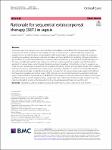Thông tin tài liệu
Thông tin siêu dữ liệu biểu ghi
| Trường DC | Giá trị | Ngôn ngữ |
|---|---|---|
| dc.contributor.author | Claudio, Ronco | - |
| dc.contributor.author | Lakhmir, Chawla | - |
| dc.contributor.author | Faeq, Husain-Syed | - |
| dc.date.accessioned | 2023-03-23T08:00:25Z | - |
| dc.date.available | 2023-03-23T08:00:25Z | - |
| dc.date.issued | 2023 | - |
| dc.identifier.uri | https://link.springer.com/article/10.1186/s13054-023-04310-2 | - |
| dc.identifier.uri | https://dlib.phenikaa-uni.edu.vn/handle/PNK/7105 | - |
| dc.description | CC BY | vi |
| dc.description.abstract | Sepsis and septic shock remain drivers for morbidity and mortality in critical illness. The clinical picture of patients presenting with these syndromes evolves rapidly and may be characterised by: (a) microbial host invasion, (b) establishment of an infection focus, (c) opsonisation of bacterial products (e.g. lipopolysaccharide), (d) recognition of pathogens resulting in an immune response, (e) cellular and humoral effects of circulating pathogen and pathogen products, (f) immunodysregulation and endocrine effects of cytokines, (g) endothelial and organ damage, and (h) organ crosstalk and multiple organ dysfunction. Each step may be a potential target for a specific therapeutic approach. | vi |
| dc.language.iso | en | vi |
| dc.publisher | Springer | vi |
| dc.subject | sequential extracorporeal therapy | vi |
| dc.title | Rationale for sequential extracorporeal therapy (SET) in sepsis | vi |
| dc.type | Book | vi |
| Bộ sưu tập | ||
| OER- Y học- Điều dưỡng | ||
Danh sách tệp tin đính kèm:

